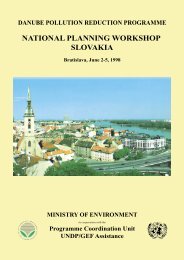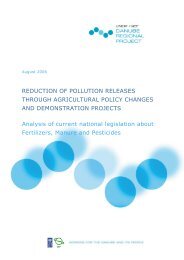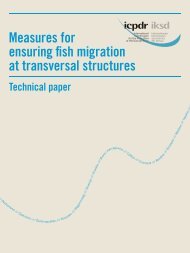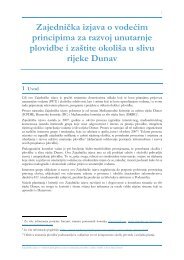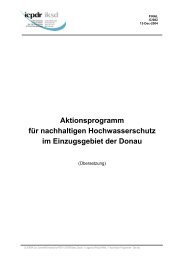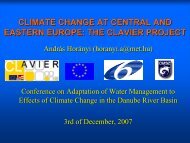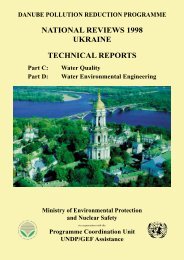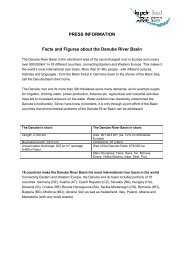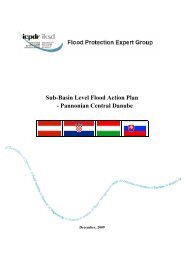Keywan Riahi: Global Challenge of Climate Change - ICPDR
Keywan Riahi: Global Challenge of Climate Change - ICPDR
Keywan Riahi: Global Challenge of Climate Change - ICPDR
Create successful ePaper yourself
Turn your PDF publications into a flip-book with our unique Google optimized e-Paper software.
<strong>Global</strong> <strong>Challenge</strong> <strong>of</strong> <strong>Climate</strong> <strong>Change</strong><br />
<strong>Keywan</strong> <strong>Riahi</strong><br />
International Institute for Applied Systems Analysis xx<br />
Graz University <strong>of</strong> Technology<br />
riahi@iiasa.ac.at<br />
Conference on Adaptation <strong>of</strong> Water Management to Effects <strong>of</strong> <strong>Climate</strong> <strong>Change</strong> in the t<br />
Danube River Basin, , Austrian Ministry for European and International Affairs<br />
Vienna, 3 December 2007
Overview<br />
• <strong>Global</strong> Perspective<br />
• Observed <strong>Climate</strong> <strong>Change</strong> (briefly)<br />
• Future Projections (and uncertainties)<br />
<strong>Climate</strong><br />
Impacts and risks<br />
Response strategies<br />
(mitigation/adaptation)<br />
<strong>Riahi</strong> #2 2007
The IPCC<br />
• Scientific body set up by WMO and UNEP<br />
• Periodic Assessment Reports (AR4 in 2007)<br />
• Hundreds <strong>of</strong> Scientists involved as Authors and<br />
Reviewers<br />
• Does not conduct own research, but assess the<br />
latest scientific, technical and socio-economic<br />
literature<br />
• Elaborate Expert and Government Review<br />
• Main findings summarized in “Summary for<br />
Policy Makers”<br />
• Nobel Peace Price 2007 together with A. Gore<br />
<strong>Riahi</strong> #3 2007
The last 200 Years<br />
1800<br />
Factor<br />
1900<br />
Factor<br />
2000 Factor<br />
2100<br />
Population<br />
(billion)<br />
1<br />
x1.6<br />
1.6<br />
x3.8<br />
6<br />
x1.2<br />
x2.5<br />
7-<br />
15<br />
GDP PPP<br />
(trillion 1990$)<br />
0.5<br />
x4<br />
2<br />
x18<br />
36<br />
GHG<br />
Concentrations<br />
over the last<br />
10000 years<br />
Source:<br />
<strong>Riahi</strong> IPCC-AR4, 2007<br />
#5 2007
Observed <strong>Change</strong>s<br />
Source:<br />
IPCC-AR4, 2007<br />
<strong>Riahi</strong> #6 2007
“Continued GHG emissions at or above<br />
current rates would cause further warming<br />
and induce many changes in the global<br />
climate system during the 21st century<br />
that would very likely be larger than those<br />
observed during the 20th century”<br />
Source: IPCC-AR4, 2007<br />
<strong>Riahi</strong> #7 2007
IPCC SRES Storylines and Scenarios<br />
g<br />
INTERGOVERNMENTAL PANEL ON CLIMATE CHANGE (IPCC)<br />
<strong>Riahi</strong> #8 2007
Per Capita Income Across SRES Scenarios<br />
Industrialized<br />
countries<br />
(Annex-I)<br />
Developing<br />
countries<br />
(non-Annex-I)<br />
100<br />
1.6<br />
1000 US$(90) per capita<br />
80<br />
60<br />
40<br />
20<br />
Income ratio:<br />
PPP: 4<br />
16.1<br />
4.2 3.0<br />
1.8<br />
0<br />
MER: 16<br />
1990 A2 B2 B1 A1<br />
Nakicenovic et al. IIASA 2000<br />
<strong>Riahi</strong> #9 2007
Night Lights<br />
2000<br />
<strong>Riahi</strong> Source: After SRES, 2000<br />
#10<br />
2007
Night Lights<br />
SRES A2<br />
2070<br />
<strong>Riahi</strong> Source: After SRES, 2000<br />
#11<br />
2007
Surface Temperature<br />
A1B, 2090-2099 2099 relative to 1980-1999<br />
1999<br />
Source: IPCC-AR4, 2007<br />
<strong>Riahi</strong> #12<br />
2007
Water Availability (Run<strong>of</strong>f)<br />
A1B, 2090-2099 2099 relative to 1980-1999<br />
1999<br />
<strong>Riahi</strong> Source: IPCC-AR4, 2007<br />
#13<br />
2007
CO2-eq. Emissions and<br />
Temperature <strong>Change</strong><br />
Scenarios without additional climate policy<br />
<strong>Riahi</strong> Source: IPCC-AR4, 2007<br />
#14<br />
2007
Impacts & Temperature <strong>Change</strong><br />
B1<br />
A2<br />
Impacts vary by:<br />
• Extend <strong>of</strong> adaptation<br />
• Rate <strong>of</strong> T-changeT<br />
• Socio-economic<br />
pathway (vulnerability)<br />
Source:<br />
IPCC-AR4, 2007<br />
<strong>Riahi</strong> #15<br />
2007
<strong>Global</strong> Primary Energy – A2r<br />
EJ<br />
2000<br />
1800<br />
1600<br />
1400<br />
1200<br />
1000<br />
800<br />
600<br />
400<br />
200<br />
Renewables<br />
Nuclear<br />
Gas<br />
Oil<br />
Coal<br />
0<br />
2000 2010 2020 2030 2040 2050 2060 2070 2080 2090 2100<br />
<strong>Riahi</strong> #16<br />
2007
<strong>Global</strong> Primary Energy – B1<br />
EJ<br />
2000<br />
1800<br />
1600<br />
1400<br />
1200<br />
1000<br />
800<br />
600<br />
400<br />
200<br />
Renewables<br />
Nuclear<br />
Gas<br />
Oil<br />
Coal<br />
0<br />
2000 2010 2020 2030 2040 2050 2060 2070 2080 2090 2100<br />
<strong>Riahi</strong> #17<br />
2007
Long-term mitigation: stabilisation and<br />
equilibrium global mean temperatures<br />
● The lower the stabilisation level the earlier global<br />
CO 2 emissions have to peak<br />
World CO2 Emissions (GtCO2)<br />
140<br />
120<br />
100<br />
80<br />
60<br />
40<br />
20<br />
0<br />
Stabilization targets:<br />
VI: 855-1130 ppm CO2-eq<br />
V: 710-855 ppm CO2-eq<br />
IV: 590-710 ppm CO2-eq<br />
III: 535-590 ppm CO2-eq<br />
II: 490-535 ppm CO2-eq<br />
I: 445-490 ppm CO2-eq<br />
post-SRES (min)<br />
post-SRES (max)<br />
-20<br />
2000 2010 2020 2030 2040 2050 2060 2070 2080 2090 2100<br />
Multigas and CO2 only studies combined
Between 1970 and 2004 global<br />
greenhouse gas emissions have<br />
increased by 70 %<br />
GtCO2-eq/yr<br />
60<br />
55<br />
50<br />
45<br />
40<br />
35<br />
30<br />
25<br />
20<br />
15<br />
10<br />
5<br />
0<br />
Total GHG emissions<br />
1970 1980 1990 2000 2004
World GHG Emissions<br />
IIASA A2r Scenario<br />
Annual GHG emissions (GtC equiv)<br />
40<br />
40 Baseline:<br />
35<br />
30<br />
25<br />
20<br />
15<br />
10<br />
5<br />
0<br />
35<br />
Baseline<br />
“Mitigation”<br />
30<br />
25<br />
20<br />
15<br />
Emissions without climate policy<br />
10<br />
5<br />
2000 2010 2020 2030 2040 20500<br />
2060 2070 2080 2090 2100<br />
CO2<br />
carbon intensity<br />
improvement<br />
Baseline: energy intensity<br />
improvement<br />
Energy conservation and<br />
efficiency improvement<br />
Switch to natural gas<br />
Fossil CCS<br />
Nuclear<br />
Biomass (incl. CCS)<br />
Other renewables<br />
Sinks<br />
CH4<br />
N2O<br />
F-gases<br />
<strong>Riahi</strong> #20<br />
2007
World GHG Emissions<br />
IIASA A2r Scenario<br />
Annual GHG emissions (GtC equiv)<br />
40<br />
40 Baseline:<br />
35<br />
30<br />
25<br />
20<br />
15<br />
10<br />
5<br />
0<br />
35<br />
Baseline<br />
“Mitigation”<br />
30<br />
25<br />
20<br />
15<br />
10<br />
5<br />
2000 2010 2020 2030 2040 20500<br />
2060 2070 2080 2090 2100<br />
CO2<br />
carbon intensity<br />
improvement<br />
Baseline: energy intensity<br />
improvement<br />
Energy conservation and<br />
efficiency improvement<br />
Switch to natural gas<br />
Fossil CCS<br />
Nuclear<br />
Biomass (incl. CCS)<br />
Other renewables<br />
Sinks<br />
CH4<br />
N2O<br />
F-gases<br />
<strong>Riahi</strong> #21<br />
2007
World GHG Emissions<br />
IIASA A2r Scenario<br />
Annual GHG emissions (GtC equiv)<br />
40<br />
40 Baseline:<br />
35<br />
30<br />
25<br />
20<br />
15<br />
10<br />
5<br />
0<br />
35<br />
Baseline<br />
“Mitigation”<br />
30<br />
25<br />
20<br />
15<br />
10<br />
5<br />
2000 2010 2020 2030 2040 20500<br />
2060 2070 2080 2090 2100<br />
CO2<br />
carbon intensity<br />
improvement<br />
Baseline: energy intensity<br />
improvement<br />
Energy conservation and<br />
efficiency improvement<br />
Switch to natural gas<br />
Fossil CCS<br />
Nuclear<br />
Biomass (incl. CCS)<br />
Other renewables<br />
Sinks<br />
CH4<br />
N2O<br />
F-gases<br />
<strong>Riahi</strong> #22<br />
2007
World GHG Emissions<br />
IIASA A2r Scenario<br />
Annual GHG emissions (GtC equiv)<br />
40<br />
40 Baseline:<br />
35<br />
30<br />
25<br />
20<br />
15<br />
10<br />
5<br />
0<br />
35<br />
Baseline<br />
“Mitigation”<br />
30<br />
25<br />
20<br />
15<br />
10<br />
5<br />
2000 2010 2020 2030 2040 20500<br />
2060 2070 2080 2090 2100<br />
CO2<br />
carbon intensity<br />
improvement<br />
Baseline: energy intensity<br />
improvement<br />
Energy conservation and<br />
efficiency improvement<br />
Switch to natural gas<br />
Fossil CCS<br />
Nuclear<br />
Biomass (incl. CCS)<br />
Other renewables<br />
Sinks<br />
CH4<br />
N2O<br />
F-gases<br />
<strong>Riahi</strong> #23<br />
2007
World GHG Emissions<br />
IIASA A2r Scenario<br />
Annual GHG emissions (GtC equiv)<br />
40<br />
35<br />
30<br />
25<br />
20<br />
15<br />
10<br />
5<br />
0<br />
40 Baseline:<br />
35<br />
Baseline<br />
“Mitigation”<br />
30<br />
25<br />
20<br />
15<br />
10<br />
5<br />
<strong>Climate</strong> <strong>Climate</strong> Policy Policy<br />
2000 2010 2020 2030 2040 20500<br />
2060 2070 2080 2090 2100<br />
CO2<br />
carbon intensity<br />
improvement<br />
Baseline: energy intensity<br />
improvement<br />
Energy conservation and<br />
efficiency improvement<br />
Switch to natural gas<br />
Fossil CCS<br />
Nuclear<br />
Biomass (incl. CCS)<br />
Other renewables<br />
Sinks<br />
CH4<br />
N2O<br />
F-gases<br />
<strong>Riahi</strong> #24<br />
2007
World GHG Emissions<br />
IIASA B1 Scenario<br />
Annual GHG emissions (GtC equiv)<br />
40<br />
40 Baseline:<br />
35<br />
30<br />
25<br />
20<br />
15<br />
10<br />
5<br />
0<br />
35<br />
Baseline<br />
“Mitigation”<br />
30<br />
25<br />
20<br />
15<br />
10<br />
5<br />
2000 2010 2020 2030 2040 2050 0 2060 2070 2080 2090 2100<br />
CO2<br />
carbon intensity<br />
improvement<br />
Baseline: energy intensity<br />
improvement<br />
Energy conservation and<br />
efficiency improvement<br />
Switch to natural gas<br />
Fossil CCS<br />
Nuclear<br />
Biomass (incl. CCS)<br />
Other renewables<br />
Sinks<br />
CH4<br />
N2O<br />
F-gases<br />
<strong>Riahi</strong> #25<br />
2007
World GHG Emissions<br />
IIASA B1 Scenario<br />
Annual GHG emissions (GtC equiv)<br />
40<br />
40 Baseline:<br />
35<br />
30<br />
25<br />
20<br />
15<br />
10<br />
5<br />
0<br />
35<br />
Baseline<br />
“Mitigation”<br />
30<br />
25<br />
20<br />
15<br />
10<br />
5<br />
2000 2010 2020 2030 2040 2050 0 2060 2070 2080 2090 2100<br />
CO2<br />
carbon intensity<br />
improvement<br />
Baseline: energy intensity<br />
improvement<br />
Energy conservation and<br />
efficiency improvement<br />
Switch to natural gas<br />
Fossil CCS<br />
Nuclear<br />
Biomass (incl. CCS)<br />
Other renewables<br />
Sinks<br />
CH4<br />
N2O<br />
F-gases<br />
<strong>Riahi</strong> #26<br />
2007
Total Energy-related Investments<br />
(World, short & long-term)<br />
200<br />
175<br />
150<br />
Long-term<br />
Investment<br />
Savings<br />
(~40 trillion)<br />
Trillion US$2000<br />
125<br />
100<br />
75<br />
50<br />
“Upfront” Investments<br />
(~2 trillion)<br />
25<br />
0<br />
A2 B1 A2 B1<br />
2000-2030<br />
2000-2100<br />
<strong>Riahi</strong> #27<br />
2007
What are the macro-economic<br />
costs in 2030?<br />
Stabilization<br />
levels<br />
(ppm CO 2<br />
-eq)<br />
Median<br />
GDP<br />
reduction[1]<br />
(%)<br />
Range <strong>of</strong> GDP<br />
reduction [2]<br />
(%)<br />
Reduction <strong>of</strong> average<br />
annual GDP growth<br />
rates [3]<br />
(percentage points)<br />
590-710<br />
0.2<br />
-0.6 – 1.2<br />
< 0.06<br />
535-590<br />
0.6<br />
0.2 – 2.5<br />
Some Impacts Appear Unavoidable<br />
(even under most stringent mitigation)<br />
• Coral bleaching<br />
• Species range shift<br />
• Drought risk and water scarcity<br />
(Mediterranean, and particularly in the dry<br />
tropics and subtropics)<br />
• Risk <strong>of</strong> wildfire<br />
• Coastal damage from floods combined<br />
with sea level rise<br />
<strong>Riahi</strong> #29<br />
2007
Timescales<br />
<strong>Riahi</strong> Source: IPCC-TAR, 2001 (recommendation Schwaiger)<br />
#30<br />
2007
Mitigation and Adaptation Need<br />
to Complement Each Other<br />
<strong>Riahi</strong> #31<br />
2007
Confronting the <strong>Challenge</strong>s <strong>of</strong> Energy for<br />
Sustainable Development:<br />
The Role <strong>of</strong> Scientific and Technical Analysis<br />
IIASA<br />
International Institute for Applied Systems Analysis<br />
presents<br />
www.<strong>Global</strong>EnergyAssessment<br />
<strong>Global</strong>EnergyAssessment.org



